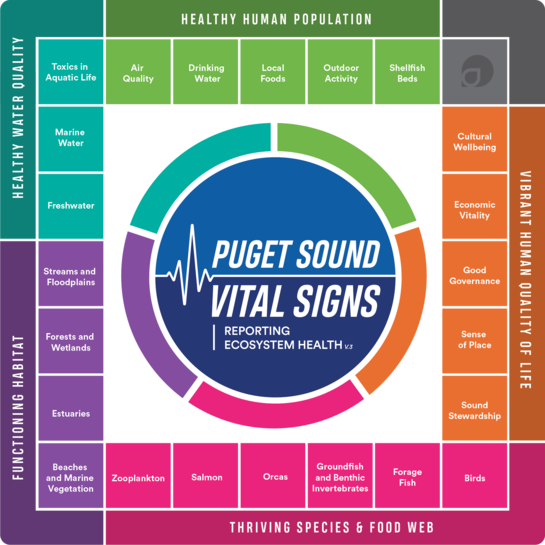
FOR IMMEDIATE RELEASE
May 18, 2022
MEDIA CONTACT: Kevin Hyde, 360.819.3045, kevin.hyde@psp.wa.gov
OLYMPIA— The Puget Sound Partnership has started reporting on a new generation of the Puget Sound Vital Signs, which measure ecosystem health, through an updated website. The website includes a new infographic for the Vital Signs, showing the relationship between the Puget Sound recovery goals and the Vital Signs.
“The Vital Signs are a transparent, credible, and accessible communication tool that highlights the problems of Puget Sound as well as success stories. They inspire action and drive the 2022-2026 Action Agenda,” said Laura Blackmore, executive director of the Puget Sound Partnership. The Action Agenda, the recovery community’s plan that charts the course of Puget Sound recovery, is scheduled for release in June 2022.
“The Vital Signs are well grounded in the latest science and will improve how we track progress of Puget Sound recovery,” said John Stein, co-vice chair of the Puget Sound Partnership’s Science Panel. “They will also let our partners and leaders at all levels and the public have a clearer picture of the state of the Sound we all care about.”
The revised Vital Signs retain many of the previous generation’s indicators, such as those for orca, salmon, and natural resource industry jobs in Puget Sound, but include new and improved Vital Signs and indicators representing more aspects of the ecosystem. The Partnership changed the Vital Signs in the following ways:
- Re-framed Vital Signs related to habitat to reflect parts of the ecosystem rather than human activities. For instance, the Vital Sign called Forests and Wetlands evolved from Land Use and Development, and Beaches and Marine Vegetation came from Shoreline Armoring.
- Combined the habitat and abundant water recovery goals and their respective Vital Signs under a single umbrella paraphrased as Functioning Habitat.
- Expanded Vital Signs to widen their scope, with Salmon replacing Chinook Salmon; Forage Fish broadening Pacific Herring. This allowed for additional species indicators.
- Added Groundfish and Benthic Invertebrates and Zooplankton as new Vital Signs.
- Included many new indicators. Examples include water temperature indicators as an important measure connected to climate change; primary production and zooplankton biomass to better understand the bottom of the food web; kelp as important habitat for salmon and many other species; and noise in marine water as a factor implicated in orca recovery.
“Monitoring efforts carried out by a network of dedicated folks from tribes, community organizations, and academia, as well as local, state, and federal governments make up the fabric of the Puget Sound Ecosystem Monitoring Program – what we call “PSEMP,” said James West, a marine ecologist at the Washington Department of Fish and Wildlife who oversees the Toxics in Aquatic Life Vital Sign. “These efforts are critical to provide the information we need to track Puget Sound recovery. It will be important to sustain PSEMP as we move forward, so we can tell whether our recovery efforts are successful."
The Puget Sound Vital Signs are part of the Puget Sound Indicators, a shared monitoring and evaluation system. The Vital Signs are complementary to the Action Agenda Progress Indicators, metrics that track changes in human activities and behaviors that the recovery community can influence through investments or policies.
The Vital Signs website housed on Puget Sound Info is the web platform where partners publish their indicator results and key messages. Anyone from the public can learn about the status and progress of Vital Signs and their indicators. As things stand, only about half the indicators show results while the other half is in development. The Partnership is actively forging new relationships to identify data streams and collaborations to support indicator reporting.
The Partnership adopted targets for certain Vital Sign indicators. Targets help articulate our long-term goals for Puget Sound. They represent iconic and valued components of the Puget Sound ecosystem and are strongly linked to the work proposed in the 2022-2026 Action Agenda. To date, Southern Resident killer whales, Chinook salmon, toxics in aquatic life, eelgrass sites, shellfish beds and swimming beaches are indicators with targets.
Nathalie Hamel, the lead for the Vital Signs reporting at the Partnership, said, “Through the Vital Signs, we track many properties of Puget Sound, from the bottom of the food web to whales and humans. Many of the indicators are clearly interconnected and sometimes they even clash. The beauty of our Vital Signs is that they challenge us to confront sometimes conflicting demands on the ecosystem.”

Resources:
Access the new Vital Signs infographic: Vital Signs visual
Vital Signs on Puget Sound Info: Vital Signs (wa.gov)
List of Vital Signs and indicators in spreadsheet form: https://pspwa.box.com/v/RevisedVSIndicators
This message has been sent to Puget Sound Partnership boards, Strategic Initiative Leads, Lead Integrating Organizations, Puget Sound Ecosystem Monitoring Program, and interested parties.
About the Puget Sound Partnership
The Puget Sound Partnership is the state agency formed to lead the region’s collective effort to restore and protect Puget Sound. Working with hundreds of government agencies, tribes, scientists, businesses, and nonprofits, the Partnership mobilizes partner action around a common agenda, advances Sound investments, and tracks progress to optimize recovery.
For more information, go to www.psp.wa.gov.
|